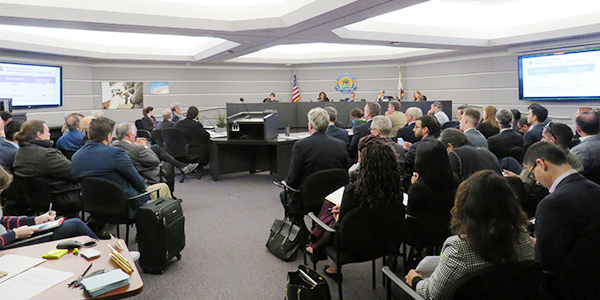By Hudson Sangree
SACRAMENTO, Calif. — In a controversial decision, the California Energy Commission on Thursday allowed the Sacramento Municipal Utility District to sell solar power to homebuilders and homeowners as an alternative to the rooftop solar panels required on all new homes built in the state after Jan. 1.
The commission adopted the cutting-edge regulations requiring rooftop solar last year but provided that “a community-shared solar electric generation system” could substitute for rooftop solar in new subdivisions. SMUD was the first utility to apply for permission to build community solar under its Neighborhood SolarShares Program last fall.
The commissioners unanimously approved SMUD’s request after a three-hour hearing, during which about 75 speakers addressed them in a hot, crowded hearing room.
Opponents argued that a decision in favor of SMUD would open the door for public utilities, community choice aggregators and eventually investor-owned utilities such as Pacific Gas and Electric to sell solar power to new subdivisions instead of each house or neighborhood having its own solar panels.
“This proposal will significantly undermine rooftop solar and storage in the SMUD territory, and it will set a precedent and a blueprint for other utilities, particularly the IOUs, to do the same,” State Sen. Scott Wiener (D), a PG&E critic, told commissioners. “Because we know that when it comes to PG&E and the other investor-owned utilities … there is no attack on rooftop solar and storage that they will not engage in because they want it to go away, and they see it as competition.”
Wiener said he regretted having to oppose SMUD, which broke away from PG&E more than 70 years ago — as San Francisco, which he represents, wants to do now — and has been a statewide leader in renewable energy.
Steven Lins, director of government affairs at SMUD, countered, “We’re focused on the big picture here, and for us that’s net-zero by 2040. That’s an audacious, aggressive goal, and we’re going to need every tool in the toolbox to get there.
“Neighborhood SolarShares is just one of many strategies that we have for reaching that goal,” he said. “It meets all the requirements. It’s just another path or option for compliance. It creates a choice for builders and buyers. Without Neighborhood SolarShares, there’s quite simply no other choice but rooftop, and that’s not what was intended in the regulations.”
Homebuilders, utility lobbyists and numerous SMUD employees spoke in favor of the community solar proposal. Not all new home buyers want rooftop solar panels, which can increase the purchase price of a house by thousands of dollars and require regular maintenance, they contended. Under SMUD’s proposal, homebuyers would have the choice of purchasing rooftop solar from builders as an add-on option or buying into the community solar program.
“Fundamental to the Energy Commission’s 2020 standards is choice,” said Frank Harris, manager of energy regulatory policy with the California Municipal Utilities Association. “In establishing the eligibility of a community solar option, the Energy Commission recognized that homeowners should have these options. The community solar program can provide a more efficient way to increase solar and maintain choice for homeowners for whom rooftop may not be the best way for introducing solar.”
Smart vs. Dumb Buildings
Environmentalists and solar industry representatives backed Wiener’s views, saying the SMUD plan would harm the movement toward rooftop solar and distributed energy resources.
“The proponents are trying to frame this as a solar-versus-solar decision, which I would imagine would be a hard choice for any and most environmentalists to make,” said Bernadette Del Chiaro, executive director of the California Solar & Storage Association.
“This is not solar versus solar,” she said. “This is the smart buildings of the future versus the dumb buildings of the past. The Energy Commission hoped for innovative community solar projects to come out of the alternative compliance option. All you’re getting today is a very commonplace utility-scale project, the likes of which the [renewable portfolio standard] will already support and bring to the fore.”
Commission staff recommended approval after SMUD agreed to make changes to its Neighborhood SolarShares proposal.
CEC Executive Director Drew Bohan said SMUD had agreed to build new solar farms within its service territory of less than 20 MW each to serve its community solar program. The utility’s initial plan could have imported power from large arrays hundreds of miles away, he said.
Controversy arose because California was the first state in the nation, starting seven weeks ago, to require rooftop solar panels on new residential construction, and opponents believed SMUD’s plan compromised that landmark achievement, Bohan said. (See Calif. Code Change Would Mandate Rooftop Solar.)
Commissioner Andrew McAllister, who oversaw the vetting of SMUD’s plan, said California must continue eliminating greenhouse gases and fossil fuels under Senate Bill 100, Assembly Bill 32 and other historic measures. The electrification of transportation and buildings is key to those efforts, and rooftop solar panels and community solar arrays should both play a role, he said.
“Building decarbonization is a huge topic. It’s a huge project for the state, certainly for the CEC, and it’s bigger than today’s discussion, I would argue,” McAllister said. “This is but one piece of that.”
He called for others to bring innovative proposals to the commission for consideration.
“We need to tend the fields of California’s diverse clean energy landscape so that all its many flowers can continue to bloom,” McAllister said.





